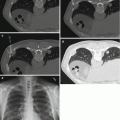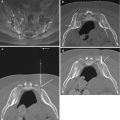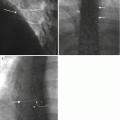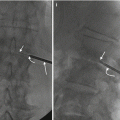, Richard Silbergleit2 and A. Orlando Ortiz1
(1)
Department of Radiology, Winthrop-University Hospital, Mineola, NY, USA
(2)
Oakland University William Beaumont School of Medicine, Royal Oak, Michigan, USA
Keywords
Complication, bleedingComplication managementComplication, preventionComplication, thromboembolicMedication, anticoagulantMedication, antiplateletMedication, thrombolyticLearning Objectives
- 1.
To learn how to evaluate and manage patients on anticoagulant and/or antiplatelet therapy prior to performing a spine or rib biopsy
- 2.
To review and update our understanding of current anticoagulant and antiplatelet medications
- 3.
To learn how to promptly address bleeding complications when they occur during or after a spine or rib biopsy
2.1 Introduction
A significant percentage of the general population is affected by medical conditions such as stroke or venothromboembolic disease or prior medical interventions such as cardiac stent placement. Another group of patients has risk factors, such as atrial fibrillation, that may predispose these patients to these medical conditions. Patients with preexisting neoplastic conditions may have hypercoagulable states that require anticoagulation therapy. Therefore, it is no surprise that many patients that are referred for a spine or rib biopsy are on antiplatelet or anticoagulant medications. Additionally, they may also be taking other medications, vitamins, or herbal supplements that alter their coagulation status. Since image-guided percutaneous spine or rib biopsy requires the use of needles and devices that may range in size from 25 gauge up to 8 gauge diameter, bleeding and hematoma formation are possible local complications that can be caused by the percutaneous insertion of these devices. When considering and planning an image-guided percutaneous biopsy procedure, it is important to not only to identify which medications that a patient is using but to determine if they have any anticoagulant properties and, if so, to decide on how to manage the administration of these latter types of medications. Managing the hemostasis risk in these patients is becoming increasingly complicated as more patients are receiving these medications and new agents are continuously being introduced into clinical practice.
The first challenge with respect to anticoagulant or antiplatelet agent management is that guidelines for holding medications vary widely and are dependent on the perceived risk of the procedure. Procedures are usually categorized as low risk, moderate (intermediate) risk, and high (significant) risk for a bleeding complication (Kohi et al. 2015). The second challenge is that different authors and professional medical societies categorize some of these procedures differently. The recommendations on holding anticoagulants and antiplatelet medications differ for the various risk categories. The third challenge is that these guidelines do not include image-guided percutaneous spine or rib biopsies in their listed procedures. Procedures that can result in intraspinal hemorrhage are considered by some experts to be high risk (Baron et al. 2013). The Society of Interventional Radiology (SIR) 2012 Consensus Guidelines for Periprocedural Management of Coagulation Status and Hemostasis Risk in Percutaneous Image-guided Interventions does not list spine biopsy but lists spine procedures including vertebroplasty and kyphoplasty as having moderate risk of bleeding (Patel et al. 2013). The American Society of Regional Anesthesia and Pain Medicine (ASRA) Guidelines on Interventional Spine and Pain Procedures in Patients on Antiplatelet and Anticoagulation Medications also does not include spine biopsies but lists vertebral augmentation (vertebroplasty and kyphoplasty) as high-risk procedures (Narouze et al. 2015). Lastly, the grades of bleeding severity are not specified or standardized across the specialties that perform image-guided percutaneous spine interventions (Baron et al. 2013).
In the setting of guidelines that are helpful but different and in risk stratification categories that are also helpful but different, what is the best way to approach the patient who is on anticoagulant and/or antiplatelet therapy and requires a spine or rib biopsy? Vertebroplasty and kyphoplasty might be considered reasonable surrogates for spine biopsy much of the time because the instruments used are similar and occasionally identical. Large needles ranging from 13 to 8 gauge in diameter are typically used for vertebral augmentation and many bone biopsies. But there is a difference between the two procedures. Vertebral augmentation procedures usually involve a single transpedicular pass and entry, either through one or both pedicles, and entail injection of acrylic bone cement within the vertebral body. Spine biopsies may entail multiple passes, with multiple tracts and entry sites, with variable access routes in addition to the transpedicular approach, with different targets in addition to the vertebral body (such as the intervertebral disk or the paraspinal soft tissues), and with no material being deposited within the biopsy site. The use of large needles in a deep location, with a variable number of passes and needle tracts, next to vital structures such as the spinal canal where bleeding cannot be easily controlled by manual compression suggests categorization as a high-risk procedure. Nevertheless, extensive experience with biopsy procedures has led many to suggest that they are of moderate risk. In practice, each biopsy is different. A biopsy of a lytic lesion in a lumbar spinous process that is not deep and that can be sampled with a smaller needle may be considered a low-risk procedure. The biopsy of suspected vascular lesion such as a metastasis from renal cell carcinoma in the cervical or upper thoracic spine would likely be considered a high-risk procedure. Image-guided percutaneous spine biopsy is a closed procedure, and since potentially uncontrollable hemorrhage can develop around and inside the spinal axis, with catastrophic consequences if not addressed emergently, it is recommended that all operators be aware of this risk and manage each case wisely: careful pre-procedure patient management, familiarity with anticoagulant and antiplatelet medications and supplements, active communication with the referring clinician and patient, and consistent post-procedure patient care (Layton et al. 2006).
Image-guided percutaneous spine biopsy is a closed procedure, and since potentially uncontrollable hemorrhage can develop around and inside the spinal axis, with catastrophic consequences if not addressed emergently, it is recommended that all operators be aware of this risk and manage each case wisely: careful pre-procedure patient management, familiarity with anticoagulant and antiplatelet medications and supplements, active communication with the referring clinician and patient, and consistent post-procedure patient care.
2.2 How to Prevent a Bleeding Complication
The best way to avoid a bleeding complication during an image-guided percutaneous spine or rib biopsy procedure is to prevent it (Hunt 2014). It is extremely important for the operator to meet the patient, review the patient’s medical history, and examine the patient. This will provide information as to the necessity for the anticoagulation and/or antiplatelet regimen. The patient may inform the operator that they have withheld these types of medications in the past for other invasive procedures. The patient can also inform the operator as to the clinician who placed them on the specific anticoagulant or antiplatelet agent. This will enable the operator to quickly contact this clinician and develop the biopsy treatment plan. Documentation of the anticoagulant/antiplatelet agent management strategy is advised. The two risks that are being balanced during this communication are the risk of procedure-related hemorrhage versus the risk of a thromboembolic event. The operator or an assistant should ask the patient if they experience easy bruising (you should also examine the arms and legs) and if they have had any bleeding problems with any other types of medical or dental procedures. Not only should the operator inquire about anticoagulant or antiplatelet medications but also about vitamins (vitamin E), fish oils, and other herbal compounds (garlic, Ginkgo biloba, ginseng, danshen, dong quai) that may affect the blood’s normal ability to form clots. At the time of the patient’s clinical evaluation, the operator can determine the type of anesthesia that may be required for the procedure. Preventing unnecessary patient movement and maximizing patient comfort during the procedure increase the likelihood of a safer procedure. Hence, the importance of identifying an uncooperative patient cannot be emphasized enough. Reviewing the prior imaging studies helps in identifying vascular structures that should be avoided and in determining optimal biopsy trajectories.
The operator should conduct a thorough investigation of the patient’s medication, vitamin, and herbal supplement use; this information should be documented in the patient’s medical record.
The operator should obtain baseline hematologic studies. This includes a coagulation profile: hematocrit and hemoglobin, platelets, prothrombin time (PT), partial thromboplastin time (PTT), and international normalized ratio (INR). A renal profile should also be obtained as many of dosing and holding recommendations for the newer anticoagulants are based on renal function: BUN, creatinine, and glomerular filtration rate. These baseline values are a useful reference in case the patient experiences a hemorrhagic event, and the new serum hematologic profile can be compared to the original values.
It is important for the operator to know the most commonly used anticoagulant and antiplatelet medications and to be aware of the newly introduced agents. Similarly, the operator should be up to date with the guidelines for the use of these agents – not only do the medications change, but the guidelines can be revised. The operator should be familiar with the use and application of bridging strategies (Tables 2.1 and 2.2). If there is any uncertainty as to whether or not an anticoagulant and/or antiplatelet agent can be held prior to arranging a biopsy procedure, then the operator should wait until the pertinent clinical issues are discussed and a biopsy management strategy is agreed to by the operator, the referring clinician, and the patient.
Table 2.1
Example of a bridging strategy using intravenous heparin
Patient admitted into hospital | |
Patient’s usual anticoagulant medication | Stopped |
Intravenous heparin therapy | Started immediately |
Intravenous heparin therapy | Temporarily held ~4 h prior to procedure |
Procedure performed | Hemostasis at puncture site confirmed |
Biopsy site monitored (at least 2 h) | |
Intravenous heparin therapy | Resumed ~4 h after the procedure |
Patient’s usual anticoagulation medication | Started |
Intravenous heparin therapy | Stopped |
Patient discharged from hospital | |
Table 2.2
Example of a bridging strategy using Lovenox
Subcutaneous therapeutic dose of Lovenox | Started |
Patient’s usual anticoagulation medication | Stopped |
Perform procedure just prior to the next scheduled Lovenox dose | Hold |
Lovenox can be resumed as early as 4 h after procedure or can wait until next scheduled administration (12 or 24 h depending on dosing schedule) | Resume |
Resume patient’s usual anticoagulation | Resume |
Warfarin – resume usual evening dose on same day as procedure | |
New anticoagulant: can start dosing after 4 h and STOP Lovenox based on effective onset of new anticoagulant (refer to Table 2.4) | |
If there is any uncertainty as to whether or not an anticoagulant and/or antiplatelet agent can be held prior to arranging a biopsy procedure, then the operator should wait until the pertinent clinical issues are discussed and a biopsy management strategy is agreed to by the operator, the referring clinician, and the patient.
In the next sections, suggestions on holding medications are made based on times necessary to reverse enough of the antiplatelet or anticoagulant effect to decrease the risk of procedurally induced bleeding to a level similar to a patient who is not on these medications. It must be recognized that this is often a challenging clinical situation for both the clinician and the patient. Patients are usually placed on these agents for a medically indicated reason. Minimizing the risk of a biopsy-related hemorrhage by holding antithrombotic medications may result in a variety of complications such as stroke, myocardial infarction, deep venous thrombosis, or pulmonary embolism. The decision to hold these medications should be made in conjunction with the service that prescribed the antithrombotic to determine if holding the medication is feasible. A spectrum of decisions may be made such as that the biopsy cannot be safely performed, the biopsy can be performed but with less than the typically recommended holding time for that agent, the biopsy can be performed after holding the specific anticoagulant or antiplatelet agent for a standard period of time, or that bridging therapy, to minimize the amount of time off antithrombotic medication, is indicated in order to perform the biopsy (Tables 2.1 and 2.2). Bridging anticoagulation therapy is used to reduce the risk of thromboembolism in patients at high risk for recurrent thromboembolic events when their anticoagulation therapy is suspended (Baron et al. 2013).
Bridging therapy may be required in patients on anticoagulation with the following conditions (Baron et al. 2013):
Mechanical heart valve | Mitral valve replacement, two or more mechanical valves, aortic valve replacement of the non-bileaflet type or with other risk factors |
Atrial fibrillation | With prior stroke or embolic event, cardiac thrombus, or CHADS score of 4 or more (1 point for congestive heart failure, hypertension, diabetes mellitus, and age 75 or older; 2 points for prior stroke or transient ischemic attack) |
Venous thromboembolism | Within prior 3 months; severe thrombophilia (protein C or S or antithrombin deficiency; antiphospholipid syndrome; homozygous for factor V Leiden or mutation in prothrombin gene G20210A or compound heterozygous mutation of these two genes) |
2.3 Antiplatelet Agents
2.3.1 Aspirin (Acetylsalicylic Acid, ASA)
Aspirin has a potent effect on platelet function that is irreversible. Its major action is through the acetylation of serine which inhibits platelet cyclooxygenase enzyme 1 (COX-1). Humans replace approximately 10% of their platelets each day. After 5 days, most patients will have 50% of their platelets functioning. Platelet transfusion can be used to restore clotting function more rapidly when necessary. There is no universally accepted test to evaluate aspirin’s effect on hemostasis. Many patients take aspirin for primary prophylaxis without a history of a cardiovascular event such as stroke or myocardial infarct. Aspirin is frequently held in these patients. When a patient with known cardiovascular disease or an implanted intravascular device is taking aspirin, this is considered secondary prophylaxis (Diener et al. 1996). Holding aspirin in a patient on secondary prophylaxis requires a careful balance of the risks of a hemorrhagic complication from the procedure with the risks of a thrombotic event related to the underlying cardiovascular condition. The latter situation is particularly concerning in patients who have undergone recent intravascular stent placement. For example, patients with coronary artery stents are usually placed on dual antiplatelet therapy for 1 year. If an elective procedure that is associated with a high risk of bleeding is being considered, then it should be delayed for at least 6 weeks in patients receiving bare metal stents or for 6 months in patients with drug-eluting coronary stents (Jneid et al. 2012). Obviously, a patient who is being considered for a biopsy will likely not be able to wait 6 months for an elective, but necessary, biopsy. Therefore, consultation with the service that prescribed the aspirin to determine the relative risks is important. It is important to realize that numerous prescription and over-the-counter medications include aspirin.
Recommendations on holding aspirin vary widely, from not holding aspirin for spine procedures to suspending aspirin use for at least 7 days (Layton et al. 2006; Baron et al. 2013). The SIR guidelines recommend not holding aspirin for low and moderate risk procedures but holding it for 5 days for procedures with a significant bleeding risk (Patel et al. 2012). ASRA guidelines recommend holding aspirin for high-risk procedures and some intermediate risk procedures, but this should be tailored to both the patient and the type of procedure (Narouze et al. 2015). The recommended holding period is 4 days when the risk is lower and 6 days when the risk is higher. Many of the guidelines do not include a recommendation for the amount of time to wait before restarting antithrombotics. ASRA recommends waiting 24 h before restarting aspirin. As can be seen by these recommendations, there is not one specific approach to this situation, but based upon our experience, we tend to hold aspirin for 5 days before performing an image-guided percutaneous spine biopsy and resume this medication the day after the procedure (Table 2.3).
Table 2.3
Some common antiplatelet medications and reversal treatment strategies
Medication | Class of drug | Half-life | Hold time | Resume time | Treatment |
|---|---|---|---|---|---|
Aspirin | COX-1 inhibitor | 20 min | 5 d | 24 h | DDAVP (0.3–0.4 mcg/kg) Platelet transfusion |
NSAIDS | COX-1 inhibitor | Variable | 24 h–10 d 5 half-lives | 24 h | DDAVP (0.3–0.4 mcg/kg) Platelet transfusion |
NSAIDS (Celecoxib) | COX-2 inhibitor | – | none | – | Does not affect platelet function |
Abciximab (ReoPro) | GP IIb/IIIA inhibitor | 10–30 min | 5 d | 8–12 h | Platelet transfusion |
Cilostazol (Pletal) | Phosphodiesterase inhibitor | 11–13 h | 24 h | 0 h Immediate | Platelet transfusion DDAVP (0.3–0.4 mcg/kg) |
Clopidogrel (Plavix) | ADP receptor antagonist | 6 h | 7 d | 0 h Immediate | Platelet transfusion DDAVP (0.3–0.4 mcg/kg) |
Eptifibatide (Integrilin) | GP IIb/IIIA inhibitor | 2.5 h | 24 h | 8–12 h | Platelet transfusion DDAVP (0.3–0.4 mcg/kg) |
Prasugrel (Effient) | ADP receptor antagonist | 7–9 h | 7 d | 24 h | Platelet transfusion DDAVP (0.3–0.4 mcg/kg) |
Ticagrelor (Brilinta) | ADP receptor Antagonist | 7–9 h | 7 d | 24 h | Platelet transfusion DDAVP (0.3–0.4 mcg/kg) |
Tirofiban (Aggrastat) | GP IIb/IIIA inhibitor | 2 h | 24 h | 8–12 h | Platelet transfusion DDAVP (0.3–0.4 mcg/kg) |
2.3.2 Dipyridamole
Dipyridamole (Persantine) inhibits adenosine uptake into platelets and potentiates the antiplatelet effects of prostacyclin (26). It has a half-life of 10–12 h. Its duration of action lasts approximately 2 days after its discontinuation (Baron et al. 2013). Aggrenox is a combination antiplatelet containing 200 mg extended release dipyridamole and 25 mg aspirin. This combination should be considered a bleeding risk. The combination should be held for 5 days before a high-risk procedure and can be resumed within 24 h. Rapid reversal of the antiplatelet effects can be achieved with DDAVP and/or platelet transfusions.
2.3.3 Cilostazol
Cilostazol (Pletal) is used to treat claudication in a patient with peripheral vascular disease. It is a phosphodiesterase III inhibitor which effects reversible inhibition of platelet aggregation. It has a clinical onset of action of 2–4 weeks with a half-life of approximately 11–13 h. Cilostazol should be held for 24 h before a high-risk procedure and can be resumed immediately after the procedure (Jaffe et al. 2015). Rapid reversal of its antiplatelet effects can be done with DDAVP and/or platelet transfusions.
2.3.4 P2Y12 Inhibitors
The P2Y12 inhibitors include ticagrelor (Brilinta) and the thienopyridine derivatives clopidogrel (Plavix), ticlopidine (Ticlid), and prasugrel (Effient). These drugs bind to the P2Y12 receptor on platelets, preventing adenosine diphosphate (ADP) from activating the glycoprotein IIb/IIIa receptor complex, thereby inhibiting platelet aggregation. P2Y12 inhibitors are often used with aspirin to provide dual antiplatelet therapy. Clopidogrel has a dose-dependent onset of action. A loading dose of 300–600 mg will result in onset of maximum antiplatelet effect in 2–5 h, while a daily dose without the loading dose will take 4–5 days. Its binding is irreversible with 40% of normal platelet function after discontinuation (Cattaneo 2008). Prasugrel with a loading dose has a faster onset of action compared to clopidogrel. Its antiplatelet effect is inversely related to the patient’s weight (Hall and Mazer 2011). Its active metabolite irreversibly binds to platelets (Cattaneo 2008). Ticagrelor also has a faster onset of action than clopidogrel but is a reversible antagonist. Platelet function (60%) is restored within 24 h after discontinuation of the medication. These drugs are held 7 days prior to a high-risk procedure. Clopidogrel can be resumed immediately after the procedure, while prasugrel and ticagrelor are held for 24 h (Jaffe et al. 2015). DDAVP and/or platelet transfusions may overcome some of the antiplatelet effects of these medications (Yorkgitis et al. 2014; McCoy et al. 2014).
2.3.5 Nonsteroidal Anti-inflammatory Drugs (NSAIDs)
NSAIDs have a reversible effect on platelet aggregation. These drugs are not typically used for their antithrombotic properties, so it is usually safe to hold NSAIDs before an elective procedure. They have widely varying half-lives leading to different recommended hold times for high-risk procedures. Diclofenac (Zorvolex), ibuprofen (Motrin, Advil), and ketorolac (Toradol) are held for 1 day. Etodolac (Lodine) and indomethacin (Indocin) are held for 2 days. Meloxicam (Mobic) and naproxen (Naprosyn, Aleve, Anaprox, Naprelan) are held for 4 days. Nabumetone (Relafen) is held for 6 days. Oxaprozin (Daypro) and piroxicam (Feldene) are held for 10 days. All are restarted 24 h after a high-risk procedure (Narouze et al. 2015).
2.3.6 Glycoprotein IIb/IIIa Inhibitors
Glycoprotein IIb/IIIa inhibitors tirofiban (Aggrastat), eptifibatide (Integrilin), and abciximab (ReoPro) are potent intravenously administered platelet inhibitors that have a very rapid onset of action (10 min for tirofiban and abciximab and 15 min for eptifibatide). The plasma half-lives range between 30 and 150 min. They are used to treat unstable angina and acute coronary syndromes and are frequently used during coronary artery interventions. Abciximab (ReoPro) should be held 5 days for medium- and high-risk procedures and resumed after 8–12 h (Narouze et al. 2015). Eptifibatide (Integrilin) and tirofiban (Aggrastat) should be held 24 h for medium- and high-risk procedures and can be resumed after 8–12 h. This is a rarely encountered scenario in the potential spine biopsy population given the primary indications for these medications. Platelet transfusions can be used to overcome the antiplatelet effects of these medications.
Stay updated, free articles. Join our Telegram channel

Full access? Get Clinical Tree








